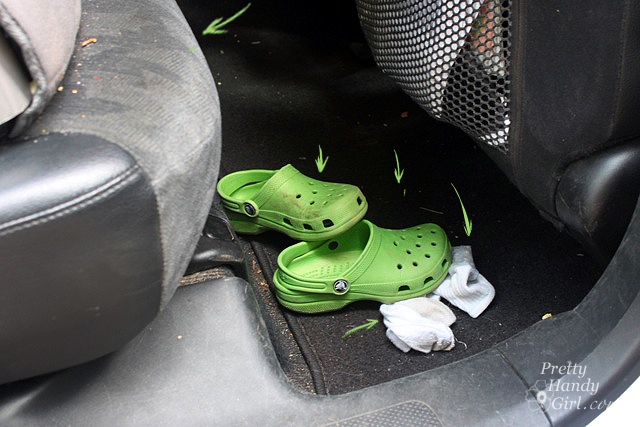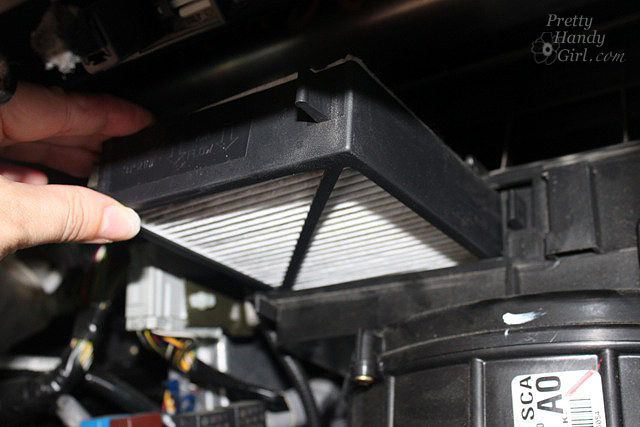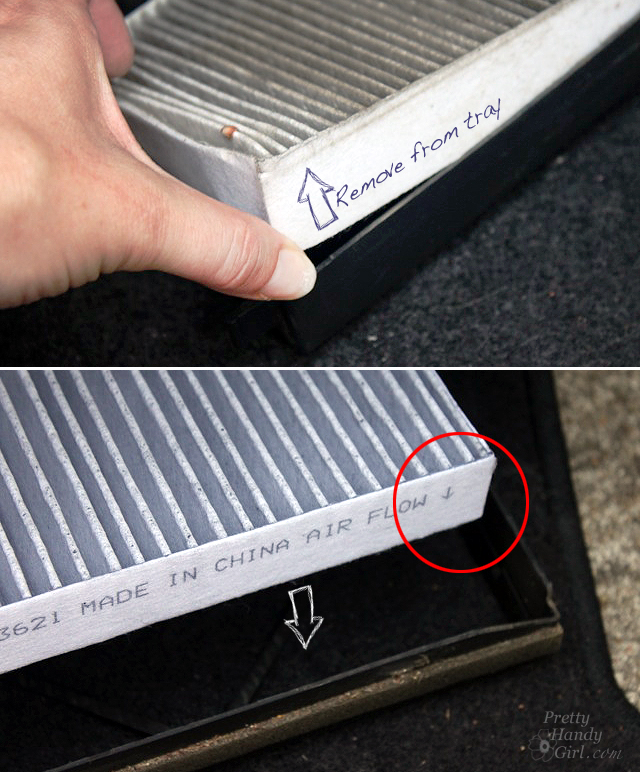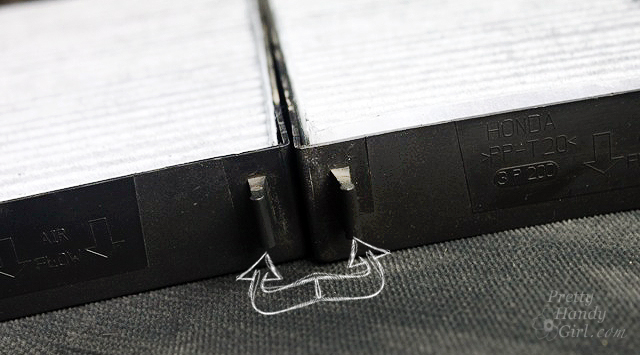Ewwww, What’s that Smell – Replace Your Car’s Cabin Filter in Minutes
Driving two boys and a dog in the Handymobile several times a day can lead to some truly funky odors. The other day I found myself wondering what the latest funk could be attributed to. Was it the stinky socks and shoes left behind from water day at school?
 Or was it the countless remnants and crumbs that tumbled out of the kids’ mouths?
Or was it the countless remnants and crumbs that tumbled out of the kids’ mouths?  Or was it just a bad case of dog breath?
Or was it just a bad case of dog breath?  There really is no telling exactly what causes the funk in my car. But, I can tell you that there could be one more culprit:
There really is no telling exactly what causes the funk in my car. But, I can tell you that there could be one more culprit:  That would be a filthy cabin air filter! This month I learned that it is easy to replace your car’s air filters. And just like you need to replace your home’s filters regularly, you should replace your car filters too! I’m embarrassed to say that I never changed my cabin filter. I just assumed the garage did it when they changed my oil four times a year. Well, I was sorely mistaken. I literally just had my oil changed this month and asked the mechanic if they automatically changed the air filter too. He answered, “Yes, ma’am. But, only if it needs it.” See, I figured I was fine. But, then I was contacted by Blogher and asked if I wanted to write a post about changing my car’s cabin air filter using a FRAM Fresh Breeze® cabin air filter. I was intrigued. And after watching the installation video on the FRAM Fresh Breeze website, I was confident knowing how to find the air filter. Okay, are you ready for this? This is the instructions for replacing your air filter on a 2003 Honda CRV. But, you can look up the instructions for your car here. Changing the cabin air filters was super simply! I can tell you that this took me under 10 minutes to do. And probably would have taken under 5 minutes if I hadn’t photographed every step. Here’s the pictorial how to guide, but you might want to look up the video tutorial for your specific car on FRAM’s website. Tools:
That would be a filthy cabin air filter! This month I learned that it is easy to replace your car’s air filters. And just like you need to replace your home’s filters regularly, you should replace your car filters too! I’m embarrassed to say that I never changed my cabin filter. I just assumed the garage did it when they changed my oil four times a year. Well, I was sorely mistaken. I literally just had my oil changed this month and asked the mechanic if they automatically changed the air filter too. He answered, “Yes, ma’am. But, only if it needs it.” See, I figured I was fine. But, then I was contacted by Blogher and asked if I wanted to write a post about changing my car’s cabin air filter using a FRAM Fresh Breeze® cabin air filter. I was intrigued. And after watching the installation video on the FRAM Fresh Breeze website, I was confident knowing how to find the air filter. Okay, are you ready for this? This is the instructions for replacing your air filter on a 2003 Honda CRV. But, you can look up the instructions for your car here. Changing the cabin air filters was super simply! I can tell you that this took me under 10 minutes to do. And probably would have taken under 5 minutes if I hadn’t photographed every step. Here’s the pictorial how to guide, but you might want to look up the video tutorial for your specific car on FRAM’s website. Tools:
- Two hands
- Maybe a flat head screwdriver
Instructions: Open your glove compartment and empty it of all the squished granola bars, unused fast food napkins and salt packets, and that key that you were looking for 5 years ago! What, no gloves in my glove box? Whoever named it a glove compartment didn’t live in the south?  Locate the stops (or glove compartment release levers) inside your glove compartment.
Locate the stops (or glove compartment release levers) inside your glove compartment.  Pry the stops out and then remove them from the glove box.
Pry the stops out and then remove them from the glove box.  Peek inside and look for the cabin filter cover. You might have to get down on all fours and look up into the dashboard.
Peek inside and look for the cabin filter cover. You might have to get down on all fours and look up into the dashboard.  Press the release lever and remove the cover.
Press the release lever and remove the cover.  Pull the first cabin filter out (your car may only have one filter, my car has two.)
Pull the first cabin filter out (your car may only have one filter, my car has two.)  Slide the tab for the second filter over to the left and remove it next.
Slide the tab for the second filter over to the left and remove it next.  Hold your nose lest you sneeze your pollen-bombed head off:
Hold your nose lest you sneeze your pollen-bombed head off:  Yuck!!! Seriously, what constitutes “when needed” in the mechanics eyes! No wonder I sneezed every time I turned on the A/C in my car! We were breathing all that pollen, tree debris, dust and who knows what else. Bleck!
Yuck!!! Seriously, what constitutes “when needed” in the mechanics eyes! No wonder I sneezed every time I turned on the A/C in my car! We were breathing all that pollen, tree debris, dust and who knows what else. Bleck!  To remove the filter, pry up the old one and insert the new one in making sure the arrows are pointing down.
To remove the filter, pry up the old one and insert the new one in making sure the arrows are pointing down.  Be sure to install the filters with the two tabs close together.
Be sure to install the filters with the two tabs close together.  Re-insert the new filters by reversing the process of removing them. 1. Insert the first filter and slide it to the right. 2. Insert the second filter. 3. Replace the cabin filter housing door. 4. Press it firmly to lock in place.
Re-insert the new filters by reversing the process of removing them. 1. Insert the first filter and slide it to the right. 2. Insert the second filter. 3. Replace the cabin filter housing door. 4. Press it firmly to lock in place.  Lift the glove box back up and re-insert the stops. Press the stops in firmly to lock in place.
Lift the glove box back up and re-insert the stops. Press the stops in firmly to lock in place.  I can certainly breathe easier knowing that the new filters I installed are clean and will filter 98% of dust, dirt, and allergens. And the Arm & Hammer® Baking soda and charcoal filter will remove odors from the air entering our car. Sayonara cigarette smoke and exhaust fumes.
I can certainly breathe easier knowing that the new filters I installed are clean and will filter 98% of dust, dirt, and allergens. And the Arm & Hammer® Baking soda and charcoal filter will remove odors from the air entering our car. Sayonara cigarette smoke and exhaust fumes.
*UPDATE: I’ve been driving around for a few days now and I can honestly say that the air in my car smells better and I haven’t sneezed once when turning on the air.  Disclosure: This is a sponsored post for FRAM via Blogher. I was sent two complimentary FRAM FreshBreeze Cabin Filters and compensation for my time. All images and copy are my own. I will always alert you when I am writing a sponsored post.
Disclosure: This is a sponsored post for FRAM via Blogher. I was sent two complimentary FRAM FreshBreeze Cabin Filters and compensation for my time. All images and copy are my own. I will always alert you when I am writing a sponsored post.




When your mechanic says he changed your air filter he means the one that filters air entering your engine that’s used for fuel combustion. Cabin filter also known as polen filter or inner space filter is something most mechanics are not really concerned about since it doesn’t affect your car performance. Your best bet is to chance it yourself which in most models shouldn’t cost you more than 20 dollars and 5 minutes of your time. It’s best to change it every 15-20k miles or more often if you drive in dusty conditions (pretty much the same as the air filter).
I know it’s counter-intuitive, but the slightly-dirty air filter actually does a better job at catching pollen and dirt than a clean one.
The filter is a bunch of fibers in a sheet that all the air gets sucked through. If there’s a little bit of dirt in the filter, that actually makes it better at trapping particles than if it’s just the filter paper/cloth/foam. (The new dirt gets stuck in clumps with the dirt that’s already there.)
Think about a dirty sink strainer–are you worried about it letting more food bits into your drain when it gets clogged? No. It just stops draining eventually. The problem with dirty air filters is likewise: if there’s too much dirt in the filter, it’s harder and harder for your HVAC blower to pull air through. twigs and leaves are definitely a problem–but they won’t necessarily make your car smelly and they don’t make it dusty.
If there’s a bunch of stuff in the filter that’s growing even tinier particles–like mold–that doesn’t get stopped by the filter anyhow, replace the filter ASAP. In that case, you’re just giving yourself a fresh blast of mold spores every time you turn on the fan. That’s not something that should normally happen, though–unless your air filter is getting wet and not drying out for some reason.
In industrial applications, they use a restriction gauge to tell you how much air is getting through the filter–when it’s too difficult for the fan to pull air through, you replace the filter. Passenger cars don’t typically have that sort of indicator, but it’s not hard to tell if your HVAC system is having a hard time blowing at full capacity. If the filter is mostly clean except for twigs and leaves, and doesn’t have anything growing on it, you can safely shake it off and re-install it. If there’s a thick, caked-on layer of dust, it’s probably clogged enough to make replacement worthwhile (unless you really feel like vacuuming it out for some reason.)
Another case that gets me to replace a filter right away is rodents. Feces and urine can foster viri and bacteria that won’t get stopped by the filter, so if you notice a rodent problem anywhere else in your car, definitely check the cabin air filter.
change filters often & open windows whenever possible
https://twitter.com/tnshadylady/status/364151916218941440
lysol and air purifier